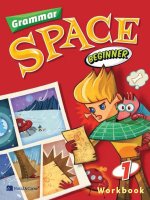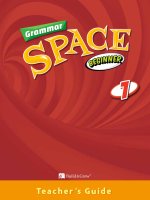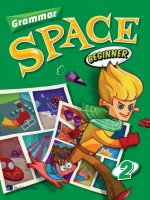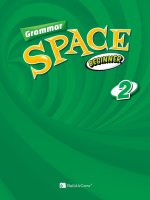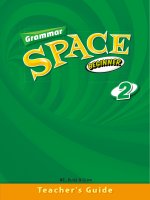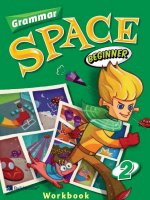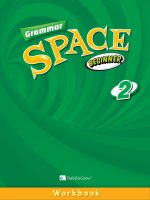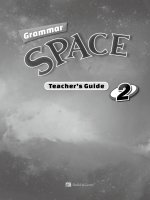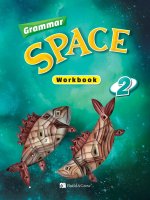Grammar space beginner 2 TG
Bạn đang xem bản rút gọn của tài liệu. Xem và tải ngay bản đầy đủ của tài liệu tại đây (23.92 MB, 81 trang )
r
a
mm
Gra
e
r
n
n
i
g
e
B
2
Te a c h e r ’s G u i d e
Grammar Space Beginner 2
Contents
2
Grammar Space Beginner 2 Teacher’s Guide
3
Unit 1 |
It’s very delicious!
Grammar Station
1. Use the chart and pictures to help you explain what the different types of sentences
are to the students. Write on the board that sentences always start with a capital
letter and end with a question mark. Then go through the four types of sentences:
statements – telling something (ex. “You are students.”), questions – asking
something (ex. “What time is it?”), imperatives – giving an order (ex. “Be quiet.”), and
exclamations – showing strong feelings (ex. “I’m so happy!”). Go through the end
Objectives
1. The students will learn about the different types of sentences.
2. The students will complete exercises to familiarize themselves with the key grammar
point.
3. The students will identify and correct simple mistakes related to the key grammar
point.
4. The students will apply their new grammar knowledge in a practical writing exercise.
5. The students will review the grammar point before the end of class to aid retention.
marks for each type of sentence, making sure to emphasize that statements always
have periods (.), questions always have question marks (?), and exclamations always
have exclamation marks (!), but imperatives can have either periods (.) or exclamation
marks (!). Leave these explanations on the board throughout the class for easy
reference.
2. Give the students as many simple examples as necessary for them to understand
the grammar point. Make sure to write these on the board using different colors, if
possible, to highlight the different parts of the sentences. You can ask the students to
give you example topics to make this portion of the lesson more interactive.
3. Extra Idea (optional):
LESSON GUIDE
Introduction
1. Ask a student to read the title out loud for the class, and then write it on the board to
Bring all the students to the board and have them each write sentences without end
marks. Then have them line up and take turns throwing a wadded-up paper ball at
the board with a blindfold on. Whichever sentence the ball lands closest to is their
sentence to complete with an end mark. Continue until all the students understand
the differences in the sentence end marks.
use as an example later.
4. When you feel that the students have a good grasp of the grammar point, draw their
2. Scan the unit before class and identify any words that your students may not
understand. Then at the start of class, post pictures or write simple definitions of the
attention to the exercise below. Have all the students read the sentences out loud and
yell, “Correct!” or “Incorrect!” while they check the correct sentences.
words on the side of the board for the students to refer back to throughout the class.
4
Grammar Space Beginner 2 Teacher’s Guide
5
Check Up
As you work through the check up and practice exercises, walk around the classroom
Practice
1. For exercise A, give the students a little bit of time to check each sentence’s type.
and encourage the students to ask you questions if they ever get confused. Also, make
Then call on individual students to read the sentences out loud, but have all the
sure to check each exercise and explain any common errors so that the students can
students yell out what type it is.
correct their answers and learn from their mistakes.
4. Extra Idea (optional):
1. For exercise A, have the students circle all the capital letters and end marks on their
Split the students into two to four groups. Have each group of students work together
own. Then ask several students to write the sentences on the board for you with the
to create a quiz for the other students about classifying sentences according to their
answers circled in. Check these sentences all together before moving on.
type. Tell each group to write six or seven sentences without end marks. Then when all
the groups are finished, have them switch quizzes with each other and work together
2. For exercise B, have the students match all the sentences together. Then have the
to put end marks on all the sentences and categorize them as statements, questions,
girls and boys alternate reading them out loud. However, tell them that they should
imperatives, or exclamations. When each group has finished taking the quiz, tell them
scoop their inflection up for questions to pronounce them correctly.
to give it back to its creators, who will then grade it. The team that has the best quiz
score is the winner.
3. For exercise C, ask several students to describe the pictures. Then have them circle
all the correct end marks for the sentences. If it looks like either end mark could be
2. For exercise B, ask several students to describe the pictures for you, including who is
correct, tell the students to look at the picture to determine which emotion is being
in them, what they are doing, and where they are. Then have the students fill in the
conveyed.
sentences on their own using the words and end marks in the box. Ask the different
sides of the class to take turns reading the sentences out loud.
3. For exercise C, put the students into pairs. Have them work together to identify what is
wrong in each underlined phrase and rewrite the sentences. As the students start to
finish the exercise, call on some of them to write the sentences on the board for you.
Grammar in Writing
1. Emphasize to the students that this writing exercise ties the grammar they have
learned into practical writing for the future. Start the exercise by asking general
questions about the writing type. Some possible ideas are:
6
Grammar Space Beginner 2 Teacher’s Guide
7
a. What is an advice column?
with any of the test questions, review the material some more.
b. What kind of advice do people ask for?
c. Do you read advice columns? Why or why not?
3. The corresponding workbook unit is intended as homework so the students can review
what they have learned at home. However, you can also go through the workbook in
2. Ask several students to describe what they see in the pictures. Then have the
class if you would like to be present for additional grammar practice with the students.
students fill in the blanks on their own from the words in the box. When everyone is
finished, have the students read through the exercise out loud all together or in turns.
3. Extra Idea (optional):
Have the students write their own advice columns to a friend that is doing poorly in
school. Encourage them to write four or five sentences with ideas that the student can
use to improve their grades. If necessary, give them this structure (with or without the
end marks) to work with: “Hi, _____. I know that _________. One good thing you can do
is ________. Do you ________? If so, you can also ________. With these ideas, you will
do really well!” Edit these advice columns and have the students take turns presenting
them at the front of the class when everyone is finished.
Review and Workbook
1. Tell the students to complete the chart at the bottom of the page as fast as they can
as a review. They shouldn’t have any problems with it by this point. While they do that,
put the chart’s structure on the board. Have the students fill it in for you as they start
finishing up.
2. Before class, print enough unit review tests for all the students from www.
nebuildandgrow.com (For Teachers → Test Sheets → Grammar → Grammar Space
Beginner 2). When everyone is finished with the review chart, have all the students
take the tests on their own. If possible, have them check their answers with a partner
or go through the tests all together before the end of class. If the students struggled
8
Grammar Space Beginner 2 Teacher’s Guide
9
ANSWER KEY: STUDENT BOOK
10
ANSWER KEY: WORKBOOK
Grammar Space Beginner 2 Teacher’s Guide
11
Unit 2 |
The sun is hot.
Objectives
1. The students will learn about the articles a, an, and the as well as count and noncount
nouns.
2. The students will complete exercises to familiarize themselves with the key grammar
point.
3. The students will identify and correct simple mistakes related to the key grammar
point.
4. The students will apply their new grammar knowledge in a practical writing exercise.
5. The students will review the grammar point before the end of class to aid retention.
3. Scan the unit before class and identify any words that your students may not
understand. Then at the start of class, post pictures or write simple definitions of the
words on the side of the board for the students to refer back to throughout the class.
Grammar Station
1. Use the chart and pictures to help you explain what articles, count nouns, and
noncount nouns are to the students. Write on the board that the articles a and an
come before singular nouns that can be counted (count nouns), while the article the
comes before nouns that cannot be counted (noncount nouns) as well as specific
count nouns and nouns that are unique. Explain to the students that liquids and
abstract ideas are usually not countable (ex. “water,” “information,” etc.), and that
the only difference between a and an is that a comes before nouns that start with
consonant sounds while an comes before nouns that start with vowel sounds. Leave
these explanations on the board throughout the class for easy reference.
2. Give the students as many simple examples as necessary for them to understand
the grammar point. Make sure to write these on the board using different colors, if
LESSON GUIDE
Introduction
1. Review the previous unit (types of sentences) before starting your lesson. Bring a
possible, to highlight the different parts of the sentences. You can ask the students to
give you example topics to make this portion of the lesson more interactive.
3. Extra Idea (optional):
Have all the students come to the board and each write two or three nouns on it
pinwheel to class with “statement,” “question,” “imperative,” and “exclamation”
anywhere they choose. Then have them make a line, and give the first student a
written on it. Then have each student spin the wheel and make whichever type of
wadded-up paper ball. Tell them to throw it at the board and say whichever noun it
sentence the spinner lands on.
lands closest to with either a or an in front of it. Then have the next student take a
turn, and so on. To make it harder, tell the students that if they land on a noun that
2. Ask a student to read the title out loud for the class, and then write it on the board to
has already been said, they have to say the in front of it instead.
use as an example later.
12
Grammar Space Beginner 2 Teacher’s Guide
13
4. When you feel that the students have a good grasp of the grammar point, draw their
attention to the exercise below. Read each phrase out loud and have them yell,
against the next one, and so on. Continue until you have a winner or run out of
flashcards.
“Correct!” or “Incorrect!” while they check the correct phrases.
Check Up
Practice
1. For exercise A and B, ask several students to describe the picture. Then have the
As you work through the check up and practice exercises, walk around the classroom
students complete the sentences in both exercises on their own as fast as they can
and encourage the students to ask you questions if they ever get confused. Also, make
while you visibly time them. Ask the fastest students to write the sentences on the
sure to check each exercise and explain any common errors so that the students can
board for you, if you like, and have the two sides of the class alternate reading through
correct their answers and learn from their mistakes.
them all.
1. For exercise A, remind the students that the is used when the noun has already been
2. For exercise C, put the students into pairs. Have them work together to identify what is
specified, and tell them to choose X if no article is need. Then have them circle the
wrong in each underlined phrase and rewrite the sentences. As the students start to
correct word in front of each noun and read the sentences all together.
finish the exercise, call on some of them to write the sentences on the board for you.
2. For exercise B, tell the students that one article in each sentence is unnecessary
and should be crossed out. Then ask a few students to write the sentences on the
board for you with the answers in them while the rest of the class reads through the
sentences all together.
3. For exercise C, ask a few students to describe the pictures. Then put the students into
pairs and have them complete the dialogues with the correct articles or no article at
all if necessary. Make sure that they practice the dialogues before you move on.
Grammar in Writing
1. Emphasize to the students that this writing exercise ties the grammar they have
learned into practical writing for the future. Start the exercise by asking general
questions about the writing type. Some possible ideas are:
4. Extra Idea (optional):
Before class, make flashcards of common count nouns and noncount nouns. Start
on one end of the room and have two students stand and compete to see who can
a. What is an advertisement?
b. What kinds of advertisements do you see every day?
c. Do you like amusement parks? Why or why not?
identify whether the noun you show them is a count or noncount noun. Then let the
winner compete against the next student, and the winner of that round compete
14
2. Ask several students to describe what they see in the pictures. Then have the
Grammar Space Beginner 2 Teacher’s Guide
15
students fill in the blanks on their own using the articles that they have learned about.
what they have learned at home. However, you can also go through the workbook in
When everyone is finished, have the students read through the exercise out loud all
class if you would like to be present for additional grammar practice with the students.
together or in turns.
3. Extra Idea (optional):
Have the students make advertisements for their own favorite amusement parks or
water parks. Encourage them to write four or five sentences describing the attractions
of their parks with as many articles as they can so that people will want to go there.
If necessary, give them this structure to work with: “_____ is ___ great amusement
park! There are _____ and ___ _____, as well. The best part is ___ _____ because it
has _____. In the evening, you can watch ___ _____. _____ is such ___ fun place!” Edit
these advertisements and have the students take turns presenting them at the front
of the class when everyone is finished.
Review and Workbook
1. Tell the students to complete the chart at the bottom of the page as fast as they can
as a review. They shouldn’t have any problems with it by this point. While they do that,
put the chart’s structure on the board. Have the students fill it in for you as they start
finishing up.
2. Before class, print enough unit review tests for all the students from www.
nebuildandgrow.com (For Teachers → Test Sheets → Grammar → Grammar Space
Beginner 2). When everyone is finished with the review chart, have all the students
take the tests on their own. If possible, have them check their answers with a partner
or go through the tests all together before the end of class. If the students struggled
with any of the test questions, review the material some more.
3. The corresponding workbook unit is intended as homework so the students can review
16
Grammar Space Beginner 2 Teacher’s Guide
17
ANSWER KEY: STUDENT BOOK
18
ANSWER KEY: WORKBOOK
Grammar Space Beginner 2 Teacher’s Guide
19
Unit 3 |
Children like stories.
Objectives
1. The students will learn about singular nouns and plural nouns.
2. The students will complete exercises to familiarize themselves with the key grammar
point.
3. The students will identify and correct simple mistakes related to the key grammar
point.
4. The students will apply their new grammar knowledge in a practical writing exercise.
5. The students will review the grammar point before the end of class to aid retention.
3. Scan the unit before class and identify any words that your students may not
understand. Then at the start of class, post pictures or write simple definitions of the
words on the side of the board for the students to refer back to throughout the class.
Grammar Station
1. Use the chart and pictures to help you explain what singular nouns and plural nouns
are to the students. Write on the board that singular nouns are for one person, place,
animal, or thing, while plural nouns are for more than one person, place, animal, or
thing (ex. “cat” vs. “cats”). Then go over the spelling rules for plural nouns (most
nouns: add –s; nouns ending in –ch, -sh, -s, -x, or –o: add –es; nouns ending in a
consonant and –y: delete the –y and add –ies; nouns ending in –f(e): delete the –f(e)
and add –ves). Leave these explanations on the board throughout the class for easy
reference.
2. Give the students as many simple examples as necessary for them to understand
LESSON GUIDE
Introduction
1. Review the previous unit (articles, count nouns, and noncount nouns) before starting
the grammar point. Make sure to write these on the board using different colors, if
possible, to highlight the different parts of the sentences. You can ask the students to
give you example topics to make this portion of the lesson more interactive.
3. Extra Idea (optional):
your lesson. Bring a deck of common count noun and noncount noun flashcards to
Bring as many students to the board as you can fit. Give them each a marker and
class with you and show one of them to each student. If it is a count noun, have the
tell them to write out the plural noun that you say as fast as possible. Then give the
student say a or an before the noun, but if it is a noncount noun, have them just say
student who correctly writes the noun the fastest a point, and bring up new students.
the noun.
Continue as long as you like, but make sure to use a variety of nouns with different
spelling rules.
2. Ask a student to read the title out loud for the class, and then write it on the board to
use as an example later.
4. When you feel that the students have a good grasp of the grammar point, draw their
attention to the exercise below. Have them match the singular and plural nouns
20
Grammar Space Beginner 2 Teacher’s Guide
21
together, and then say the singular nouns at random and have all the students yell out
jackets. Go around the room and have each student say, “I have ___ _____.” The one
their plurals together.
with the most objects of the same type is the winner. Make sure all the objects are
returned to their original owners after the game is done.
Check Up
As you work through the check up and practice exercises, walk around the classroom
and encourage the students to ask you questions if they ever get confused. Also, make
Practice
1. For exercise A, ask several students to describe everything in the picture. Then read
sure to check each exercise and explain any common errors so that the students can
through the nouns in the box above and have the students all say their plural forms.
correct their answers and learn from their mistakes.
Give the students ten seconds to complete the sentences with the plural nouns
while you visibly time them, and then call on individual students to read through the
1. For exercise A, have the students circle the correct words on their own. Then have the
sentences.
class read through the sentences all together to check them.
2. For exercise B, have the students underline the object nouns in the starting sentence
2. For exercise B, ask several students to describe the pictures. Then have the students
of each problem before doing anything else. Then have them complete the second
complete the sentences on their own and ask a few of the fastest to come to the
sentences with the plural forms of those nouns. If you like, you can ask several
board and write the correct spellings of the plural nouns. If you like, have the two sides
students to write the answers on the board for you.
of the classroom alternate reading the sentences as loud as they can.
3. For exercise C, put the students into pairs. Have them work together to identify what is
3. For exercise C, read through the singular nouns on the left and have the students all
say their plural forms. Then have the students complete the sentences on their own
wrong in each underlined phrase and rewrite the sentences. As the students start to
finish the exercise, call on some of them to write the sentences on the board for you.
and ask the fastest students to put the correct spellings of the plural nouns on the
board for you. If you like, you can ask the boys and girls to alternate reading through
the sentences as quietly as possible.
4. Extra Idea (optional):
Tell the students that you are going to have an objects competition. Explain that they
need to find as many of the same item as they can anywhere in the classroom, bring
them to their desks, and sit down within the space of 30 seconds. For example, one
student may find 12 pencils, another may find 15 books, and another may find 8
22
Grammar in Writing
1. Emphasize to the students that this writing exercise ties the grammar they have
learned into practical writing for the future. Start the exercise by asking general
Grammar Space Beginner 2 Teacher’s Guide
23
questions about the writing type. Some possible ideas are:
Beginner 2). When everyone is finished with the review chart, have all the students
a. What is a recipe?
take the tests on their own. If possible, have them check their answers with a partner
b. Why do we use recipes?
or go through the tests all together before the end of class. If the students struggled
c. Do you use recipes to cook? Why or why not?
with any of the test questions, review the material some more.
2. Ask several students to describe what they see in the pictures. Then have the
3. The corresponding workbook unit is intended as homework so the students can review
students fill in the blanks on their own from the words in the box. When everyone is
what they have learned at home. However, you can also go through the workbook in
finished, have the students read through the exercise out loud all together or in turns.
class if you would like to be present for additional grammar practice with the students.
3. Extra Idea (optional):
Have the students write their own recipes for a simple snack or dish that they often
make for themselves (ex. a sandwich, ramen, popcorn, etc.). Encourage them to write
four or five lines with as many plural nouns as possible. If necessary, give them this
structure for a sandwich recipe to work with: “It is easy to make ______! First, take
two pieces of _____. Put some _____ and _____ on them, as well as two slices of
_____. If you want, you can also add _____, _____, and _____. When you are ready, put
the _____ of _____ together and enjoy your sandwich!” Edit these recipes and have
the students take turns presenting them at the front of the class when everyone is
finished.
Review and Workbook
1. Tell the students to complete the chart at the bottom of the page as fast as they can
as a review. They shouldn’t have any problems with it by this point. While they do that,
put the chart’s structure on the board. Have the students fill it in for you as they start
finishing up.
2. Before class, print enough unit review tests for all the students from www.
nebuildandgrow.com (For Teachers → Test Sheets → Grammar → Grammar Space
24
Grammar Space Beginner 2 Teacher’s Guide
25
ANSWER KEY: STUDENT BOOK
26
ANSWER KEY: WORKBOOK
Grammar Space Beginner 2 Teacher’s Guide
27
Unit 4 |
I like him.
words on the side of the board for the students to refer back to throughout the class.
Grammar Station
Objectives
1. The students will learn about pronouns, subject pronouns, and object pronouns.
2. The students will complete exercises to familiarize themselves with the key grammar
point.
3. The students will identify and correct simple mistakes related to the key grammar
point.
4. The students will apply their new grammar knowledge in a practical writing exercise.
5. The students will review the grammar point before the end of class to aid retention.
1. Use the chart and pictures to help you explain what pronouns, subject pronouns, and
object pronouns are to the students. Write on the board that pronouns are short words
that replace nouns, and that subject pronouns replace subject nouns (i.e. “I,” “you,”
“he,” “she,” “it,” “we,” “they,”) while object pronouns replace object nouns (i.e. “me,”
“you,” “him,” “her,” “it,” “us,” “them”). You may need to remind the students that
subjects do an action while objects have an action happen to them (ex. “Cathy hit
Alice.” → “She hit Alice.” vs. “Cathy hit her.”). Leave these explanations on the board
throughout the class for easy reference.
2. Give the students as many simple examples as necessary for them to understand
the grammar point. Make sure to write these on the board using different colors, if
possible, to highlight the different parts of the sentences. You can ask the students to
LESSON GUIDE
Introduction
give you example topics to make this portion of the lesson more interactive.
3. Extra Idea (optional):
Bring a pinwheel with all the subject pronouns written on it to class with you. Have
1. Review the previous unit (singular nouns and plural nouns) before starting your lesson.
each student come to the front all at once, spin the pinwheel, run back to their desk,
Show each student a flashcard of a common singular noun and have them say and
and write their subject pronoun, the correct form of be, and the appropriate name of
spell its plural.
someone(s) in the class (including their own, if applicable). For example, if a student
spun “We,” they might run back and write “We are Tom and Jessica.” Repeat as often
2. Ask a student to read the title out loud for the class, and then write it on the board to
as you want and have the students read their sentences out loud when you’re finished.
use as an example later.
4. When you feel that the students have a good grasp of the grammar point, draw their
3. Scan the unit before class and identify any words that your students may not
understand. Then at the start of class, post pictures or write simple definitions of the
28
attention to the exercise below. First, have them circle all the subject pronouns.
Then have them underline the object pronouns. You may need to prompt them by
Grammar Space Beginner 2 Teacher’s Guide
29
asking which person/word is doing the action or having the action done to it. Then
4. Extra Idea (optional):
have all the students read the sentences out loud, but have them put their hands in
Draw a few buildings on the board as well as a horizontal line to indicate a landscape.
the air when they read any subject pronouns and on the desk when they read object
Then have all the students come to the board and take turns drawing as many people
pronouns.
doing activities with or to each other as they can in the space of a couple of minutes.
Then have all the students make a line, and one by one blindfold them, spin them
around, and have them walk to the board and touch a random spot. The picture
closest to where they touch is their subject, and they should practice making a simple
three-word sentence in the form “subject pronoun + verb + object pronoun.” If they
happen to touch a drawing with no obvious subject or object pronoun, quickly draw a
Check Up
stick figure doing something there. Continue until the students understand how to use
both types of pronouns.
As you work through the check up and practice exercises, walk around the classroom
and encourage the students to ask you questions if they ever get confused. Also, make
sure to check each exercise and explain any common errors so that the students can
correct their answers and learn from their mistakes.
1. For exercise A, have the students circle the correct words to complete the sentences
on their own. Then have all the students read the sentences together. If you like, you
can have them use their hands to indicate which people are doing the action or having
it done to them.
Practice
1. For exercise A, ask several students to describe the picture. Then have the students
write the pronouns based on the indicated nouns as fast as they can. Call on individual
students to read through the sentences when everyone has finished.
2. For exercise B, write each starting subject on the board, draw arrows pointing below
them, and then have the whole class work together to think of the subject pronouns
2. For exercise B, demonstrate how to work backwards from the object pronoun to find
they can change into, which you can write on the board below the arrows. When you
out what the original noun was. Then call on an individual student to read through the
are finished, call on individual students to read through the sentences out loud.
first sentence, but have all the students shout out what they think the answer is. Let
the original student choose the next person to read, who chooses the next person,
3. For exercise C, ask several students to describe the pictures, including who is in
and so on.
them, what they are doing, and where they are. Then have the boys and girls alternate
reading the lines all together. After each first line, write the object noun(s) on the board
30
3. For exercise C, put the students into pairs. Have them work together to identify what is
like you did in the previous exercise and have the whole class brainstorm together
wrong in each underlined phrase and rewrite the sentences. As the students start to
what its object pronoun is. Then continue with the second line.
finish the exercise, call on some of them to write the sentences on the board for you.
Grammar Space Beginner 2 Teacher’s Guide
31
Grammar in Writing
1. Emphasize to the students that this writing exercise ties the grammar they have
Review and Workbook
1. Tell the students to complete the chart at the bottom of the page as fast as they can
learned into practical writing for the future. Start the exercise by asking general
as a review. They shouldn’t have any problems with it by this point. While they do that,
questions about the writing type. Some possible ideas are:
put the chart’s structure on the board. Have the students fill it in for you as they start
a. What kind of stories do you like? Why?
finishing up.
b. What is your favorite story? Why?
c. Do you like trick-or-treating? Why or why not?
2. Before class, print enough unit review tests for all the students from www.
nebuildandgrow.com (For Teachers → Test Sheets → Grammar → Grammar Space
2. Ask several students to describe what they see in the pictures. Then have the
Beginner 2). When everyone is finished with the review chart, have all the students
students fill in the blanks on their own using the pronouns that they have learned.
take the tests on their own. If possible, have them check their answers with a partner
When everyone is finished, have the students read through the exercise out loud all
or go through the tests all together before the end of class. If the students struggled
together or in turns.
with any of the test questions, review the material some more.
3. Extra Idea (optional):
3. The corresponding workbook unit is intended as homework so the students can review
Have the students write their own stories about trick-or-treating (if they have never
what they have learned at home. However, you can also go through the workbook in
been trick-or-treating, explain what it is and tell them to imagine what it would be like).
class if you would like to be present for additional grammar practice with the students.
Encourage them to write about four or five sentences with as many pronouns as they
can similar to the story in the previous exercise. If necessary, give them this structure
to work with: “I go trick-or-treating with my mom and dad each year. ___ always have a
great time! The neighbors give ___ candy, and ___ show ___ my costume. My parents
also wear costumes. ___ dress as ghosts and scare ___. ___ love Halloween!” Edit
these stories and have the students take turns presenting them at the front of the
class when everyone is finished.
32
Grammar Space Beginner 2 Teacher’s Guide
33
ANSWER KEY: STUDENT BOOK
ANSWER KEY: WORKBOOK
ANSWER KEY: Review Test 1
34
Grammar Space Beginner 2 Teacher’s Guide
35
Unit 5 |
The cap is mine.
Objectives
1. The students will learn about possessive adjectives and possessive pronouns.
2. The students will complete exercises to familiarize themselves with the key grammar
point.
3. The students will identify and correct simple mistakes related to the key grammar
point.
4. The students will apply their new grammar knowledge in a practical writing exercise.
5. The students will review the grammar point before the end of class to aid retention.
understand. Then at the start of class, post pictures or write simple definitions of the
words on the side of the board for the students to refer back to throughout the class.
Grammar Station
1. Use the chart and pictures to help you explain what possessive adjectives and
possessive pronouns are to the students. Write on the board that possessive adjectives
come before nouns and show who owns something (ex. “This is my seat.” “That is her
coat.”). Then explain that both possessive adjectives and their nouns can be replaced
with possessive pronouns when the listener knows what object is being referred to (ex.
“This is mine.” “That is hers.”). Go through all the possessive adjectives (i.e. “my,”
“your,” “his,” “her,” “its,” “our,” and “their”) and possessive pronouns (i.e. “mine,”
“yours,” “his,” “hers,” “ours,” “yours,” and “theirs”). Last, explain that ’s can be added
to a name or noun to indicate that that person or noun owns the following object (ex.
“Dan’s room,” “the cat’s dish”). Leave these explanations on the board throughout the
class for easy reference.
LESSON GUIDE
Introduction
1. Review the previous unit (subject pronouns and object pronouns) before starting
2. Give the students as many simple examples as necessary for them to understand
the grammar point. Make sure to write these on the board using different colors, if
possible, to highlight the different parts of the sentences. You can ask the students to
give you example topics to make this portion of the lesson more interactive.
your lesson. Show each student a simple sentence with either the subject or object
underlined (ex. “Henry helped Anne.”). Have each student read their sentence while
switching the underlined portion for the correct pronoun (ex. “Henry helped her.”).
3. Extra Idea (optional):
Grab a bunch of different things from the students’ desks. Then have them each come
up one at a time, find the object you took from them, say, “This is my _____,” and sit
2. Ask a student to read the title out loud for the class, and then write it on the board to
use as an example later.
back down. If you want, you can let them take any object they want as long as they say
the owner’s name in place of “my.” Then those owners can go, take their object back,
say, “No, this is my _____,” and sit back down. Of course, make sure that all the things
3. Scan the unit before class and identify any words that your students may not
36
are returned to their rightful owners by the end of the game.
Grammar Space Beginner 2 Teacher’s Guide
37
4. When you feel that the students have a good grasp of the grammar point, draw their
4. Extra Idea (optional):
attention to the exercise below. Say each subject pronoun at random and have the
Have the students pick partners out of a hat. Teach the students to say, “Whose is
students chant its possessive adjective and possessive pronoun after you. Feel free to
this/that?” to ask about ownership of an object. Then have the students take turns
expand to subject pronouns not included in the exercise. When you are finished, have
with their partner pointing at objects and asking, “Whose is this/that?” for their
the students match the pronouns and adjectives on their own.
partners to answer, “This/That is _____.” Encourage them to use a variety of objects
and possessive pronouns. If you think it is feasible, you can let the pairs move about
the classroom while they point at objects. Of course, make sure that all objects end up
with their rightful owners at the end of the activity.
Check Up
As you work through the check up and practice exercises, walk around the classroom
and encourage the students to ask you questions if they ever get confused. Also, make
sure to check each exercise and explain any common errors so that the students can
correct their answers and learn from their mistakes.
Practice
1. For exercise A, ask several students to describe the pictures to you. Then demonstrate
how to complete the example sentence with possessives, and have the students finish
1. For exercise A, demonstrate how to change the example possessive adjective + noun
phrase into a possessive pronoun. Then have the students finish the rest of the
the rest of the exercise on their own. Call on individual students to read through the
sentences when they are done.
exercise on their own. When they are finished, say the phrases at random and have
the students all yell out the correct pronouns.
2. For exercise B, use the example dialogue to demonstrate how to ask and answer
about ownership. Then have the students pick partners out of a hat or bag and work
2. For exercise B, use the example sentence to point out that possessive pronouns are
only used when the possessive adjective + noun phrase has already been clarified.
together to complete the rest of the dialogues. Have each pair roll a die to see which
dialogue they have to perform in front of the class.
Then have the students complete the exercise on their own and tell the two sides of
the class to take turns reading the sentences as loud as they can.
3. For exercise C, keep the students in their pairs. Have them work together to identify
what is wrong in each underlined phrase and rewrite the sentences. As the students
3. For exercise C, ask several students to describe the pictures. Then put the students
into pairs and have them complete the dialogue answers together, explaining that
start to finish the exercise, call on some of them to write the sentences on the board
for you.
whose asks about ownership of an item. Make sure that they practice the dialogues
when they are finished.
38
Grammar Space Beginner 2 Teacher’s Guide
39
Grammar in Writing
1. Emphasize to the students that this writing exercise ties the grammar they have
learned into practical writing for the future. Start the exercise by asking general
questions about the writing type. Some possible ideas are:
a. What is your favorite story? Why do you like it?
2. Before class, print enough unit review tests for all the students from www.
nebuildandgrow.com (For Teachers → Test Sheets → Grammar → Grammar Space
Beginner 2). When everyone is finished with the review chart, have all the students
take the tests on their own. If possible, have them check their answers with a partner
or go through the tests all together before the end of class. If the students struggled
with any of the test questions, review the material some more.
b. What are the kings in stories usually like?
c. Why is it good to be honest?
3. The corresponding workbook unit is intended as homework so the students can review
what they have learned at home. However, you can also go through the workbook in
2. Ask several students to describe what they see in the pictures. Then have the
class if you would like to be present for additional grammar practice with the students.
students fill in the blanks on their own using the possessives that they have learned.
When everyone is finished, have the students act out the story.
3. Extra Idea (optional):
Have the students write their own stories about owning treasure like the previous
exercise. Encourage them to write four or five sentences with as many possessive
adjectives and pronouns as they can. If necessary, give them this structure to work
with: “King/Queen _____ found some treasure, so it is ___. Many people think the
treasure is ___, though. They take ___ weapons and attack _____ castle. _____
soldiers fight them and win. _____ is so happy that he/she tells the soldiers that ___
treasure is ___, too.” Edit these stories and have the students take turns presenting
them at the front of the class when everyone is finished.
Review and Workbook
1. Tell the students to complete the chart at the bottom of the page as fast as they can
as a review. They shouldn’t have any problems with it by this point. While they do that,
put the chart’s structure on the board. Have the students fill it in for you as they start
finishing up.
40
Grammar Space Beginner 2 Teacher’s Guide
41
ANSWER KEY: STUDENT BOOK
42
ANSWER KEY: WORKBOOK
Grammar Space Beginner 2 Teacher’s Guide
43
Unit 6 |
He’s a mail carrier.
Objectives
1. The students will learn how to use the verb be in positive sentences, negative
sentences, and yes/no questions.
2. The students will complete exercises to familiarize themselves with the key grammar
point.
3. The students will identify and correct simple mistakes related to the key grammar
point.
4. The students will apply their new grammar knowledge in a practical writing exercise.
5. The students will review the grammar point before the end of class to aid retention.
3. Scan the unit before class and identify any words that your students may not
understand. Then at the start of class, post pictures or write simple definitions of the
words on the side of the board for the students to refer back to throughout the class.
Grammar Station
1. Use the chart and pictures to help you explain to the students how to use the verb be
in positive sentences, negative sentences, and yes/no questions. Write on the board
that the verb be changes into am, are, or is depending on the subject, and that we put
not after it to form negative sentences (ex. “You are a kid.” “She is not happy.”). Then
demonstrate how to make yes/no questions with the verb be by putting it before the
subject, and how to answer these questions by putting it after the subject (ex. “Is he
handsome?” → “Yes, he is.” / “No, he isn’t.”). Last, show the students how to make
contractions in both the positive (ex. “I am” → “I’m,” “We are” → “We’re,” etc.) and
negative forms (ex. “are not” → “aren’t,” “is not” → “isn’t”). Leave these explanations
on the board throughout the class for easy reference.
LESSON GUIDE
Introduction
2. Give the students as many simple examples as necessary for them to understand
the grammar point. Make sure to write these on the board using different colors, if
possible, to highlight the different parts of the sentences. You can ask the students to
give you example topics to make this portion of the lesson more interactive.
1. Review the previous unit (possessive adjectives and pronouns) before starting your
lesson. Ask each student, “Whose is that?” while pointing to an object, and have them
respond, “That is _____.”
3. Extra Idea (optional):
Write different common nouns on cards with a piece of tape on the back of them, and
stick them on the students’ foreheads without them seeing the words. Then have
2. Ask a student to read the title out loud for the class, and then write it on the board to
use as an example later.
the students wander around and ask their classmates, “Am I a _____?” and have the
classmates respond, “Yes, you are,” or “No, you aren’t.” Encourage the students to
narrow down their objects with questions like, “Am I an animal/object?” The student
that figures out what they are first is the winner.
44
Grammar Space Beginner 2 Teacher’s Guide
45
4. When you feel that the students have a good grasp of the grammar point, draw their
attention to the exercise below. Read each phrase out loud and have the students yell,
“Correct!” or “Incorrect!” while they check the correct phrases.
Practice
1. For exercise A, demonstrate how to complete the sentences with the indicated form
of the verb be. Then ask five volunteers to come to the board and compete to write
the sentences that you give them as fast as possible. Check these sentences before
moving on.
2. For exercise B, ask several students to describe the picture for you, including who is in
Check Up
As you work through the check up and practice exercises, walk around the classroom
it, what they are doing, and where they are. Then have the students draw partners out
of a hat or bag and complete the dialogues together. Roll a die to see which pairs have
to perform them for the class.
and encourage the students to ask you questions if they ever get confused. Also, make
sure to check each exercise and explain any common errors so that the students can
correct their answers and learn from their mistakes.
3. For exercise C, keep the students in their pairs. Have them work together to identify
what is wrong in each underlined phrase and rewrite the sentences. As the students
start to finish the exercise, call on some of them to write the sentences on the board
1. For exercise A, have the students circle the correct words on their own. When they are
for you.
finished, have them all read the sentences out loud together to check them.
2. For exercise B, remind the students that singular nouns should have is after them,
while plural nouns should have are. Then go through the sentences as a class and
have the students call out which forms of be they think should go in the blanks.
3. For exercise C, ask several students to describe the pictures. Then put the students
into pairs and have them work together to complete the dialogue answers. Make sure
that they practice the dialogues when they are finished, and call on different pairs to
read through them in front of the class.
Grammar in Writing
1. Emphasize to the students that this writing exercise ties the grammar they have
learned into practical writing for the future. Start the exercise by asking general
questions about the writing type. Some possible ideas are:
a. What is a donation?
4. Extra Idea (optional):
Have all the students write down three different be questions on slips of paper and
b. Who or what do people donate to?
c. Do you donate money? Why or why not?
put them into a bag or hat. Then have them make a line, draw out the questions,
read them out loud, and answer them in full sentences. If any of the questions have
mistakes in them, have the students that picked them identify and fix them.
2. Ask several students to describe what they see in the picture. Then have the students
fill in the blanks on their own using the correct forms of the verb be. When everyone is
finished, have the students read through the exercise out loud all together or in turns.
46
Grammar Space Beginner 2 Teacher’s Guide
47
3.Extra Idea (optional):
ANSWER KEY: STUDENT BOOK
Have the students write their own donation requests like the previous exercise for
victims of an earthquake. Encourage them to write four or five sentences and use
the verb be as much as possible. If necessary, give them this structure to work with:
“_____ ___ a boy/girl in _____. _____ ___ poor because of an earthquake. Good food
___ rare in _____ town, so _____ and his/her family ___ hungry and sick. You ___ ___
hungry and sick. Will you help _____ and his/her family?” Edit these requests and
have the students take turns presenting them at the front of the class when everyone
is finished.
Review and Workbook
1.Tell the students to complete the chart at the bottom of the page as fast as they can
as a review. They shouldn’t have any problems with it by this point. While they do that,
put the chart’s structure on the board. Have the students fill it in for you as they start
finishing up.
2.Before class, print enough unit review tests for all the students from www.
nebuildandgrow.com (For Teachers → Test Sheets → Grammar → Grammar Space
Beginner 2). When everyone is finished with the review chart, have all the students
take the tests on their own. If possible, have them check their answers with a partner
or go through the tests all together before the end of class. If the students struggled
with any of the test questions, review the material some more.
3.The corresponding workbook unit is intended as homework so the students can review
what they have learned at home. However, you can also go through the workbook in
class if you would like to be present for additional grammar practice with the students.
48
Grammar Space Beginner 2 Teacher’s Guide
49
